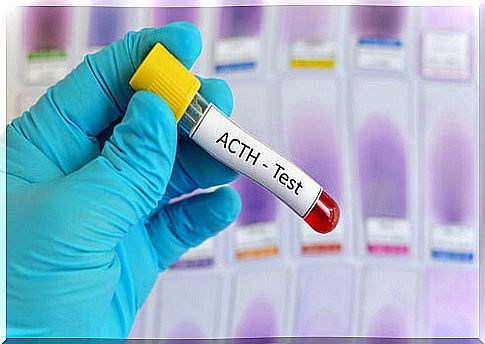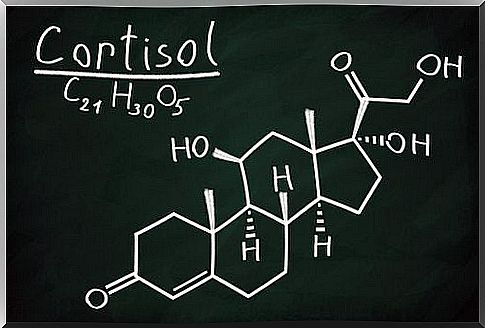Adrenocorticotropic Hormone: Characteristics And Functions

The adrenocorticotropic hormone or adrenocorticotropin (ACTH) is a hormone that comes from the pituitary. This is the main endocrine gland of vertebrates, also called the pituitary gland. The hormones it secretes control the function of almost all the other endocrine glands in the body (1).
Thus, adrenocorticotropic hormone is a corticotrophic cell. These mainly produce corticotrophic hormones that they place in the center. The characteristics of this specific hormone are detailed below.
Synthesis of adrenocorticotropic hormone
This hormone is synthesized from a protein called proopiomelanocortin (POMC). This precursor protein is made up of 266 amino acids, and the adrenocorticotropic hormone is made up of 39 amino acids. In addition, proopiomelanocortin also generates other peptides such as:
- Lipotropin.
- Endorphin.
- Met-enkephalin.
- Melanocyte stimulating hormone.
- Corticotropin-like midlobe protein (CLIP).

Adrenocorticotropin secretion
The secretion of adrenocorticotropic hormone is pulsatile. This means that it follows a characteristic circadian rhythm. Thus, it reaches its maximum at six o’clock in the body and its minimum at midnight.
Thanks to the secretion of adrenocorticotropin, adrenal glucocorticoids are secreted, following a parallel diurnal pattern. Finally, the biological half-life of ACTH in the circulation is less than ten minutes.
Modulators of ACTH synthesis and / or secretion
Stimulators
- CRH (main modulator).
- TNF (tumor necrosis factor).
- IL-1 (interleukin-1).
- CKK (cholecystokinin).
- VIP (vasoactive intestinal peptide).
- Alpha-adrenergic stimuli.
- Acetylcholine.
- Serotonin
Inhibitors
- Cortisol (main modulator).
- GABA.
- Endorphins.
- Encephalins.
- Activin.
- Galanin.
- PNA (Atrial Natriuretic Peptide).
- Substance P.
Mechanism of action of adrenocorticotropic hormone
Adrenocorticotropic hormone acts through a membrane receptor. This receptor is called melanocortin receptor 2, a G protein-coupled receptor. CAMP acts as a second biological messenger.
Action
The adrenocorticotropic hormone works as follows:
- It preserves the homeostasis of metabolism and mediates the endocrine reaction to stress.
- Induce steroidogenesis. This is a set of metabolic reactions that mainly make possible the synthesis of steroid hormones in a certain organ or tissue (corticosteroids, androgens, and to a lesser extent mineralocorticoids).
- Stimulates skin pigmentation, which is determined by the amount of melanin in the skin. This is because it contains in its molecule the sequence of the
- In addition, it produces a certain degree of lipolysis : the breakdown of dietary lipids into fatty acids during digestion.
Frequently, ACTH and adrenal axis inhibition occurs clinically due to the use of corticosteroids. For example, in asthma, collagen diseases and hematological diseases (1).
ACTH-related diseases
Cushing’s syndrome
This syndrome includes a constellation of clinical and biochemical abnormalities that result from chronic exposure to excess cortisol produced by the adrenal cortex. Between 80 and 85% of this syndrome is caused by an adrenocorticotropic hormone-producing pituitary adenoma (3).
The differential diagnosis of Cushing syndrome is one of the greatest challenges in endocrinology. Although the clinical manifestations are obvious in many cases, in others they can be very subtle. Weight gain with central fat redistribution affecting the face, neck, trunk, and abdomen is one of the most common clinical findings (4).
Thus, other important clinical data are the presence of facial plethora, hirsutism, acne, menstrual disorders, hypertension, proximal muscle weakness, stretch marks, carbohydrate intolerance or diabetes (5).

Addison’s disease (6)
Addison’s disease is a syndrome characterized by a lack of gluco and / or mineralocorticoids. In this case, poor adrenocorticotropic hormone production may occur, leading to decreased glucocorticoid production (secondary hypoadrenocorticism).
Secondary hypoadrenocorticism (SAH) can be natural or iatrogenic. The natural form is due to the absence of normal adrenal stimulation by CRH or ACTH and denotes a primary hypothalamic or pituitary failure. Thus, most of these cases are the result of inflammation, tumors, trauma, or hypothalamic or pituitary birth defects.
The iatogenic form is the most common form of SAH in veterinary medicine and occurs due to exogenous administration of glucocorticoids, which suppress normal pituitary ACTH production. This promotes bilateral adrenal atrophin.
Addison’s disease is a slow and progressive process. It is caused by insufficient supply of adrenal cortical hormones to the normal demands of the body. Thus, they have their origin in the bilateral destruction of the adrenal cortex. In addition, the symptoms do not begin to appear until the loss of 90% or more of the adrenal tissue (7).
Thus, adrenocorticotropic hormone is a key hormone in the proper functioning of the nervous system. In fact, its malfunction involves some diseases like the ones we have seen, in addition to other hormonal disorders. Much research remains to be done on this hormone, but the importance of its role in the body seems clear.









